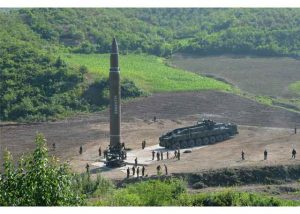On the morning of the Fourth of July, North Korea successfully tested a previously-unseen missile, referred to in their reports as the Hwasong-14. The missile splashed down in the Sea of Japan. According to analysis of its extremely high flight path by David Wright of the Union of Concerned Scientists, the missile could theoretically travel at least 6,700 km. The Hwasong-14 is therefore an Intercontinental Ballistic Missile (ICBM) in both name and practice; it exceeds the minimum 5,500 km by which ICBM capability is conventionally defined, and it is capable of reaching Alaska.
The test is the 11th in a series that North Korea has conducted in 2017 to demonstrate various missile capabilities, but the Hwasong-14 is the first ICBM. South Korean experts interviewed by NK News conjecture that North Korea built the new missile by adding a second stage to the medium-range Hwasong-12 (also known as KN-17). According to the regime mouthpiece Korean Central News Agency (KCNA), the test launch demonstrated not only unprecedented range but also a functioning re-entry vehicle, high accuracy, a warhead detonation mechanism, and the ability to carry a “large-sized heavy nuclear warhead.” All are necessary for carrying out a successful ICBM strike, but only the range can be confirmed. There is no information on which to judge North Korea’s progress on improving missile accuracy, a serious challenge over ICBM ranges, and it is equally unclear if the country has succeeded in miniaturizing and hardening a warhead for ICBM delivery. While the range improvement is a worrying step, this test is not yet proof that North Korea can use nuclear weapons against targets in North America.
Images released by Rodong Sinmun, a North Korea newspaper, show the Hwasong-14 transported by a specialized vehicle known as a transporter erector launcher (TEL), which NK News experts identify as being of Chinese origin. With such a mobile system the Hwasong-14 could easily hide from attack in the rugged terrain of North Korea. Other tests this year of intermediate-range systems showed off tracked off-road TELs and quick-firing solid-fueled missiles, which are even harder to destroy on the ground. This test therefore suggests that a military solution to the missile threat, in addition to precipitating catastrophic retaliation against the city of Seoul, would probably not succeed.
The primary effect of this test, as 38 North expert John Schilling emphasizes, is to create uncertainty. Maybe the Hwasong-14 is inaccurate, limited in mobility, unable to deliver a functional warhead, or just a one-off success unlikely to be repeatable in the stress of wartime. But we can’t discount the possibility that it will work exactly as advertised. As this blog has consistently maintained, then, the only viable path to reduce the threat is through serious diplomatic engagement.
~ John Walsh, Intern at the Center for Arms Control and Non-Proliferation

